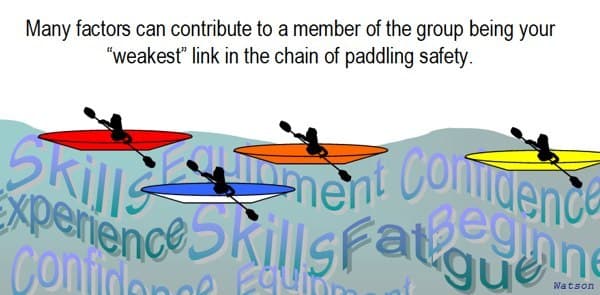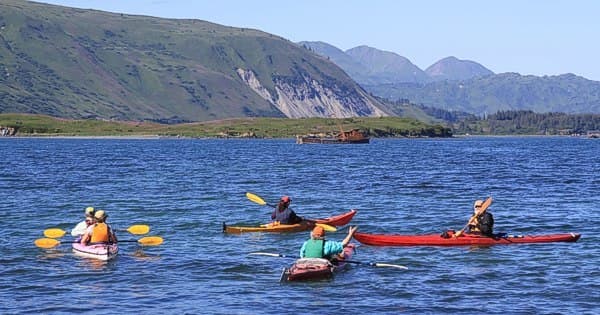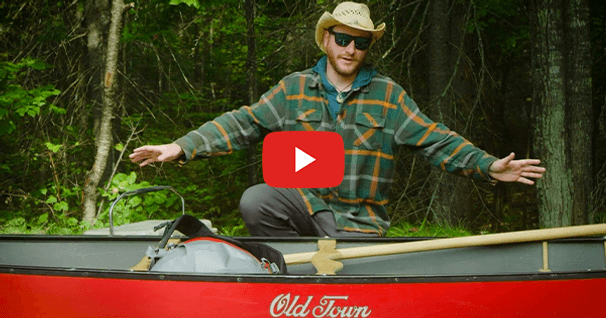The Group Paddle - Preparation & Group Dynamics
A kayaking buddy, we'll call him "Ben", is one heck of a paddler. He's got years of big, blue water experience. He has quality equipment and knows how to use it against almost everything Nature can throw at him. Ben charges forward from shore, never looks back over his shoulder and tends to put a lot of distance between himself and everyone else. Ben's a solid, steadfast kayaker. And although he's always way out in front of the rest of us, he's clearly not the leader when it comes to understanding the dynamics of a group.
Whether you are heading out on a multi-day paddle with old buddies or a mix of casual acquaintances, the dynamics of the group are important from the pre-trip preparation stage all the way through the on-water experiences until the last kayak's bow is nosed into the sand at the end of the trip. Each paddler's abilities, experience levels, overall awareness and even attitudes will play a vital role.
Knowing Individual's Skills
One of the many important aspects of the group profile is determining any "weakest links" among the paddlers. This doesn't mean the worst paddler; it means the least skilled or prepared (through ability, gear or even confidence), to handle all the situations the group may encounter. A fantastic inland waters paddler may have never experience surf landings or someone with years of coastal touring may have never dealt with extended, open water crossings. Knowing each member's range and level of skills are important factors in determining a group's collective courses of action throughout the trip.

Buddy System
It's vital that each member of the team knows that, as a group, no action should ever compromise an individual's safety, nor should an individual's action jeopardize everyone else. Whenever we went swimming at summer camp in the Boy Scouts, we followed the "Buddy System" approach to watch each other's back. All the while we were in the water, we'd keep an ear out for "the whistle". Every fifteen minutes it was blown, signaling a splashing scramble to join up with your assigned buddy, clasp hands and raise them high above the water. If you couldn't get to your buddy quick enough you each had sand time coming for five minutes.
It's good to know someone's got your back while kayaking, too! Partnering up on the water heightens your safety response environment, individually and collectively. It's human nature that most newly introduced paddlers tend to pair up with others at their same skill levels. When a dicey paddling situation arises, a more skilled paddler can always take a concerned paddler under his/her wing and either continue forward or lead a segment of the group through a safer, less challenging alternative.
For the group's sake, it would be preferable not to have to alter the adventure dramatically because it turns out one or more members doesn't have the skill sets to carry forward. Yet, from a safety standpoint, that may be the ultimate decision a prudent group is forced to make. Bottom line - the overall dynamics of a group is the sum of its collective and varying parts.
Organizing / Leading
A group usually has an organizer, if not actual paddling "leader", who should at least assume the role of coordinating all the aspects of pre-trip planning and preparation – or at a minimum a run-through of a check list before departing. One valuable pre-trip exercise that I have found to be potentially helpful is each group members' ability to perform a self-rescue and/or assist in a team rescue. Some members may never have performed a rescue before while others have had but one casual pool session of instruction.
Before a week-long paddle through Voyageurs National Park a few years back, I put everyone through a basic rescue drill to let them experience a capsize and what all is involved in re-entry and emptying boat procedures. Group members don't have to necessarily do it well, but practice does make towards perfect and having the "feel" for a rescue beforehand may make the real-life execution of it go more smoothly.

Gear Assessment
What type of kayaks/gear each member uses warrants at least casual scrutiny, especially if certain open water conditions might have negative affects on certain designs. Will the shorter, wider or rudderless kayak have trouble keeping up and on course through all the windy crossings we expect to make? How much of the shared gear load will a narrow, shallow kayak be able to carry? Who all has spare paddles? These are not necessarily weighty issues, but they do express the kinds of concerns a good leader should consider.
Speaking of sharing the load, another aspect of the buddy system is splitting the gear as in the case where one kayaker carries the two-person tent while the other stows both sleeping bags. A leader can assist in making sure that gear is not forgotten and also being used to trim kayaks properly. Most often what to bring and how to pack it are aspects of each individual's routine already, so a good leader might only double check the process as part of overall preparations.
Float Plans
One important and critical group task will be to file a Float Plan. Members should have his/her personal float plan to be left with their own contacts. Collectively the groups float plan should be left either with a primary contact at home or at a harbormaster office or other official location near the initial launch site.
There are several formats for float plans, and all the information listed is important, particularly:
- Information on each member of the party (and as back-up for each individual's plan filed with his/her own family)
- Type and color of every kayak in the group: SAR teams need to know exactly what boats they are looking for. It saves time and can help them gather information from other's sightings. "We saw four kayaks, two red and two yellow…" is much better than just, "There were a few kayaks…" Knowing there is a mix of doubles and singles helps as well.
- Some groups carry a dining/camp tarp with distinguishing colors or symbols on it…. List anything you think might be a significant stand out.
- Type of emergency communication devices.
Packing in a Group
Other group planning efforts are basically the same as an individual only on a larger scale. Everyone will still carry their own snacks in addition to the group's stash of munchies to be share during breaks. Food prep and other duties are tasks the group leader can at least oversee to make sure some things are not overlooked. Popular food packing methods include putting all the fixings for each specific meal (breakfasts, lunches, etc) into one color of storage sacks; the other method is to pack all the food you'll need for each days meals (Mon., Tues., etc.) in their own marked sacks. In either case, those group supplies can be divvied out among paddlers as space and trim weights allow. Larger cooking implements (Dutch oven, fry pan, grills, etc.) and even stove fuels should be divvied out as well.
It may be necessary in some situations to pool individual material resources to deal with injuries or repairs. A solo kit may not have a sufficient supply (as in first aid treatments) or the proper tool (camp stove repair, fixing a broken rudder, etc.) to provide for group needs and therefore requires a broader inventory of components. A "group kit" should therefore be an extension of the contents typically found in an individual kit – and then some:
First Aid Kits – If a member of the group has a particular medical/health issue, are prescriptions involved? Are those clearly marked and does everyone know where they are kept? Are dosages clearly printed? Also, is anyone allergic to any medications or to insects, plants and other critters? If a victim becomes unconscious, these questions need to have answers everyone knows or can learn quickly.
Today's market includes specialty kits for myriad types of adventures featuring activity-specific contents. Some kits use impressive amounts of cheap adhesive bandages to build up their presumed value, while others have quality materials but not in numbers adequate to sustain a group’s needs. A group kit therefore might contain a supply of compresses, ointments and even stouter utensils than are found in an individual kit. A group's first aid pack might also contain treatments for potential ailments one might encounter throughout your anticipated paddling environment.
Repair Kits – Things break, usually when you need them most and usually when you have no access to parts. With so many options for gear and types within each gear family, having the right parts is completely item specific. Therefore carrying what's going to work is pretty much individualized by what each paddler uses for gear (stoves are a good example). It is probably best to insist each member has those essential parts along.
Another specific repair may be a patch job on a boat or paddle. Some chemistry is limited in its applications on certain plastics and other synthetic surfaces. It's therefore important to know which fix won't further damage a boat through an adverse chemical reaction. Some members might carry an all-purpose air/water cure compound while others carry alternate chemistry for a particular hull material. Extra rudder cables, clips, etc. can be combined into a concise, wide-range repair kit. Likewise how many needle-nose pliers, screwdrivers and such will you need? Of course each member should already have his or her own kits and then, too, you can never have too much duct tape!
Survival Kits – Since the cardinal rule regarding survival kits is, "If you don't have it on you, you don't have it!" every member should carry their own emergency survival kit as part of their absolutely necessary gear. Still, a larger, more inclusive survival pack for the group can contain either extra supplies or additional and perhaps bigger survival equipment (pistol or parachute flares in addition to an individual's personal pocket flares). Two or three-person shelters are more efficient than a larger shell so emergency tube tents and also bivy sacks might be carried along.
Even on short, afternoon trips its advisable to have along what I call a "Capsize Kit". It's comprised of a personal change of underlayering, a pair of wool socks and wool cap along with basic provisions (bottle of water, energy bar) stuffed into a small compression sack and stowed up into the forward/aft recesses of you kayak. A small fire starter, tube tent, signal mirror and maybe spare batteries might also be added to round out such kits.
It's not meant to be your overall emergency survival kit, but rather a comfort kit for a capsize recovery situation where you just want to warm up on the beach before continuing onward. In a group situation, even these capsize kits could come in handy as backup to other survival/emergency and safety gear. Leave it in your kayak all summer long, a hidden life-saver tucked away and hopefully never used.
**************
Leadership A leader usually emerges from among those within a well-balanced group. Typically it's the paddler with the best local knowledge of the area, known routes and particulars associated with the ultimate destination. It's natural for them to draw upon prior experience and competency to assume the "lead" in the group.
As important as that front edge leader is, especially in a group of less familiar paddlers, is a sweeper (either individual or team) at the trailing edge of your mini armada who helps keep the group together. Even among a few buddies, it's away the safest formation when the distance from front to back is such that swift response is possible should something happen anywhere within your on-water entourage.
Sharing the paddling experience with old and new friends is one of the many appealing aspects of kayaking. Preparation is like prevention in health: better to anticipate and deal with a potential problem before it happens rather than scramble to play catch-up afterwards. Being prepared doesn't mean bad things still can't happen, it just means we are ready to deal with when Ma Nature – or our own lack of good judgment - brings it on. Group dynamics feed off of individuals who are collectively and continually interacting – and work out a responsible and equitable way to deal with it all.
Be safe and have fun out there.
Tom Watson is an avid sea kayaker with 15 years experience in the North Pacific waters of Kodiak Island, Alaska. He is also a freelance writer whose articles have appeared in most of the popular kayaking publications. He is a frequent presenter at regional kayak symposia. He is author of "How to Think Like A Survivor" (published in 2005) available on Amazon.com and most major bookstores.
Related Articles
Walker from Old Town shares a quick tip on how to pack a balanced canoe to help ensure better tracking…
We’ll take a look at the kit that I often choose to carry that I can access while afloat. This setup is…
Creekboating is as much a game of strategy as it is a sport. Half of your time on creeks is spent…
Experienced wilderness canoe trippers know that small errors can cause big problems. In my previous…



